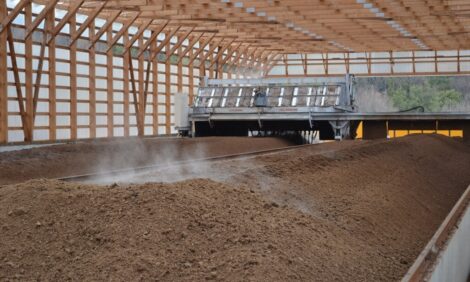



The economics of a short hatch window
By Pas Reform - In hatcheries all over the world, hatchery managers and owners place great importance on the uniformity and liveability of the chicks they produce.
This is not without good reason – day-old flocks showing poor uniformity are impossible to manage properly, which will result in lower growth, increased feed conversion (FCR) and higher mortality rates. Flock uniformity is acknowledged as being highly dependent on the duration of the hatch window. As the spread of hatch increases, so too does the number of chicks that are feed deprived for a longer period before gaining free access to feed and water. Consequently, a large hatch window leads to more chicks being ‘left behind’, thus increasing variety in the size of the chicks. As poor uniformity in young birds is compounded during growth, this will lead to further problems during processing.
Meat product uniformity is an important goal in the processing industry, because it allows for a more accurate food supply and cost prediction. Customers of processing plants precisely define the product specification of chicken portions and whole birds. These specifications can only be met by broilers of a particular bodyweight range. Consequently, birds which fall outside this so-called ‘prime size’ range are processed less efficiently and are, therefore, less desirable to processors.
In this article, we discuss how uniform batches of chicks can be achieved by good hatchery management when combinedwith the right incubation technology – and we will see how hatch window sizes can greatly affect the economic success of hatcheries, farmers and processors.
Flock uniformity
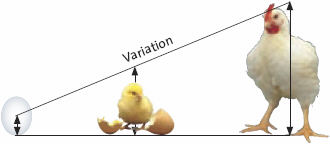 Figure 1 |
During the first week of life, when broilers are expected to grow three to five-fold, time without access to feed has a major impact on growth and feed conversion. In this period, several of the chick’s physiological systems are not yet matured. Among these is the thermoregulatory system, meaning that during the first days of their lives, newly hatched chicks have little or no ability to regulate their own body temperature. As environmental temperature decreases, so too does the internal temperature of the chick.
Since small chicks have a higher surface:volume ratio, they lose more heat than large chicks. Consequently, small chicks may benefit from an environmental temperature that is 2°C higher than large chicks. Furthermore, air that is too cool will prevent chicks from getting adequate feed and water, because their response to getting cold is to huddle together to conserve warmth, which prevents them from getting to feeder lids and drinkers. Next to the development of the thermoregulatory system, the complete development of the digestive tract and immune system are equally essential.
Maturation of the digestive and immune systems depends on the chick getting all the nutrients and antibodies provided in the yolk sac in its first few days of life, and after that, absorbing suffi cient nutrient from feed. If chicks are unable to get enough feed and water, mortalities will occur. Thus, during the brooding period, the chick is highly dependent on its environment. Good management, especially during the first 48-72 hours of a chick’s life, is crucial to maximise performance and liveability.
In order to realise optimum conditions for a maximum number of chicks, uniformity of day-olds is a prerequisite. Minimizing variation in chick size may furthermore reduce competition within the flock and thus decrease mortality, increase growth rate and improve uniformity by marketing weight when the birds enter the processing plant. Uniformity of day olds is, therefore, highly valued by the hatcheries’ customers, the farmers.
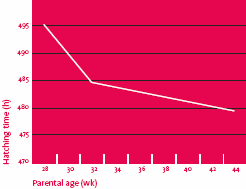 Figure 2: Embryos of young parent flocks require more incubation time. |
Managing the hatch window
The duration of the hatch window depends on two key factors – firstly, that all the embryos in a batch are at an equal stage of their development at the start of incubation, and secondly, that all the eggs in one incubator at a time are developed at a uniform rate. The following is a summary of factors and recommendations known to affect the management of the hatch window.
Maternal age. Maternal age directly affects the rate of embryonic development. Embryos from ‘pubescent’ flocks (< 32 weeks) require longer incubation periods than embryo’s from ‘mature’ flocks (>32 weeks). It has been suggested that at the moment of oviposition, the eggs of the latter group contain embryos in a more advanced state that develop at a higher rate than those from younger flocks. Some studies even report a decrease in incubation time up to 10 hours between 28 and 32 weeks of parental age! (see Fig. 2. Data from Shanawany, 1984; Mather and Laughlin, 1979). It is, therefore, recommended that hatching eggs should be sorted according to parental age prior to incubation, as incubating eggs from parent flocks of different ages will inevitably lead to differences in hatching time and thus extend the hatch window.
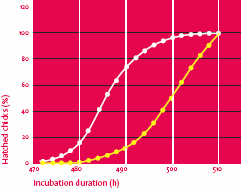 Figure 3: Distribution of hatch related to egg storage time. |
Homogeneous incubation temperature. To achieve a short spread of hatch requires an even start to the embryonic development of each egg inside the incubator, and homogenous temperature at the start of incubation for every egg is fundamental to uniform development. In this respect, it is important to realise that batches of eggs may require different times for heating up to incubation temperature, for example because of different storage or transport temperatures, or due to differences in egg size. Pre-heating the eggs for several hours to achieve a uniform start temperature (preferably between 21-25 °C) reduces variations in temperature inside the eggs at the start of incubation, and will produce a more uniform start to the development of eggs in one machine, so reducing the spread of hatch.
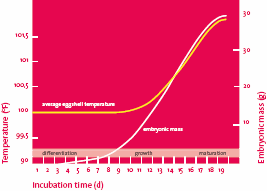 Figure 4: Growth curve and the incubation pattern of the eggshell temperature for chicken in setter for optimum hatchability and uniform hatch. |
As eggs incubated in multi-stage machines vary in embryonic age, the younger eggs in the incubator need to be heated up, while the eggs in later phases are at the same time producing heat that must be removed. The average eggshell temperature may vary from 37.5°C for the youngest embryos to 39.5 °C for the later embryonic stages (see Fig. 4). Because the temperature in multi-stage incubators is operated at a fi xed set point, temperature gradients are created at egg shell level in these machines and the spread of hatch will increase. Indeed, hatching chicks are sometimes spotted at the moment of transfer in multistage practice, indicating that hatch windows of 2-3 days are occurring.
To achieve a uniform hatch, incubation temperature must be accurately controlled and homogenously distributed - so that each single embryo experiences the same incubation temperature. Homogenous temperature is, therefore, best achieved in a single-stage incubator, divided into separate units, each with its own climate control. During the first week of the single-stage incubation process, a temperature difference between trays of 0.2 °F is acceptable, and this may tolerably increase to a difference of 0.5 °F during the fi nal week.
Economics of a short hatch
As we have seen, dehydrated chicks that are held in the hatcher for extended periods produce sub-optimal broiler performance in flocks, seen as higher (and thus worse) feed conversion ratios. It is probable that these dehydrated chicks account for differences in FCR that have shown up in comparative fi eld studies around the world, to measure the effi ciencies of multi- versus single-stage incubation. We have also seen that the effects of delayed feed uptake (> 24 hours) persist up to slaughter age, leading to higher proportion of birds that fall outside the desired weight, or ‘prime size’, range. We will see that these effects have significant economic consequences in broiler production:
Improved feed conversion. Every hour that a chick’s environment is less than optimal, its energy is used inefficiently and growth is reduced, resulting in increased feed conversion ratios. In optimised conditions, however, improvements of between 4-7 points FCR have been reported. Assuming the lower fi gure of four points improvement produces the following calculation: One incubator with a capacity of 115,200 eggs in single stage operation is used 17 times per year. Assuming a hatch of 85%, with 5% broiler mortality in the subsequent broiler growth phase, this single machine will produce 115,200 x 17 x 85% x 95% = 1.58 million broilers at slaughter weight ready for processing. If we assume slaughter weight of 2.2 kg, then four points of feed conversion improvement translates into 88g of feed saved per broiler. For an entire year, therefore, the feed saved by this incubator is 1.58 million x 88 g = 139,040 kg of feed per year.
Increase of chicks inside prime size range. As we have said, meat product uniformity is an important goal in the processing industry, because it allows for more efficient processing. Birds which fall outside the desired weight range, the so-called ‘prime size’ range, are, therefore, less valued by processors. As narrow hatch windows will lead to a more uniform end product, one can expect an increase in income as a direct result of an increased share of prime sized birds.
In studies in Asia and Europe, differences between prime size category prices and outside category dressed birds are in the range of € 0.04/kg live weight. Assume that from 60% of the flock being in the prime size weight range, this percentage could be improved to 80%, then 20% of the birds could be sold at a premium of € 0.04 per kg. If we go back to the example of a large incubator of 115,200 eggs, and incubate at 85% hatchability and 95% liveability, the machine will produce 1.58 million day old chicks for the processing plant each year. 20% of 1.58 million therefore represents an increase in prime bird sizes with 0.2 x 1.58 million = 316,000 birds x 1.7 kg = 537,200 kg of prime size birds per year.
Improvements produced by single stage incubation in terms of better feed conversion rates and higher percentages of prime size birds can, therefore, amount to a total difference on investment per machine per year of up to 139,040 kg of feed and 537,200 kg of prime size birds. In Europe this would translate to a feed saving of approximately € 30,000 per machine per year, and assuming the premium of € 0.04, an extra income for prime size birds of € 20,000 which mounts to a total amount of € 50,000 per year.
Concluding remarks
In conclusion, a delay of more than 24 hours before first feed intake has been shown to depress weight gain up to slaughter age, and poor uniformity in day olds complicates farm management. The prediction of hatching time and minimising the spread of hatch are, therefore, crucial to the achievement of optimum results. It is accepted that temperature gradients in incubators lead to differences in embryonic developmental rate and, therefore, to their time of hatching.
Hence, multi-stage incubation naturally produces larger hatch windows than single-stage incubation. And we have shown that by employing the single-stage incubation process, we can narrow the hatch window to produce significant economic benefits, expressed as improved feed conversion and higher percentages of prime sized birds at slaughter weight. These benefits are entirely significant to the economics of broiler production for meat processing. Next to optimising the uniformity of hatching eggs by sorting them on weight, factors such as parental age and storage time should also be taken into account, to homogenise embryonic development.
In this respect, it is clear that single-stage incubation delivers measurable benefits in terms of productivity and profitability. By enabling greatly improved accuracy in terms of hatchery planning and forecasting, we can be assured of an even more uniform hatch.
References available on request
- Flock uniformity: the percentage of birds whose weight falls within 10% of the flock’s average weight.
- Hatch time: often referred to as the moment of chick collection.
- Hatch Window: the time span during which a determined majority of chicks have hatched.
- Prime size birds: the percentage of birds in the desired weight range.








